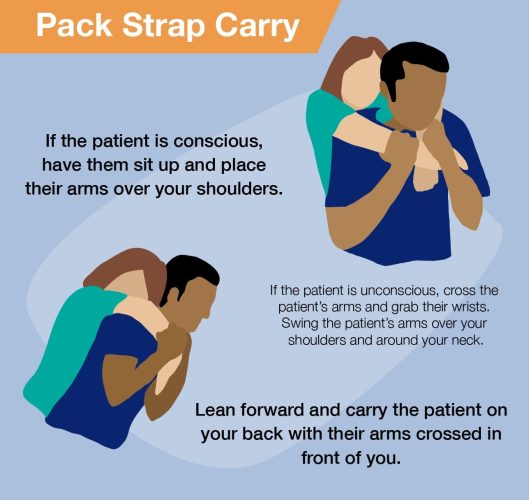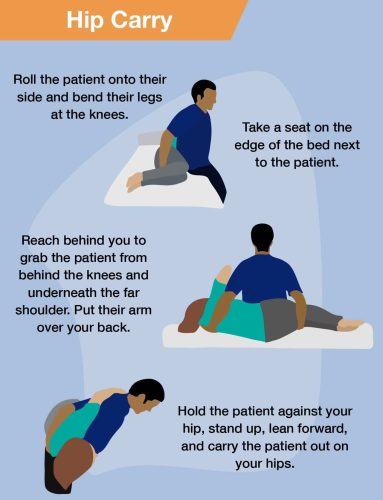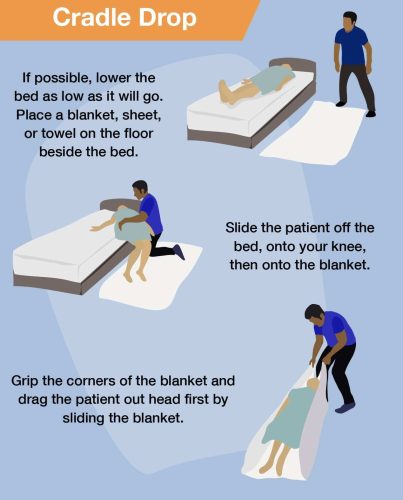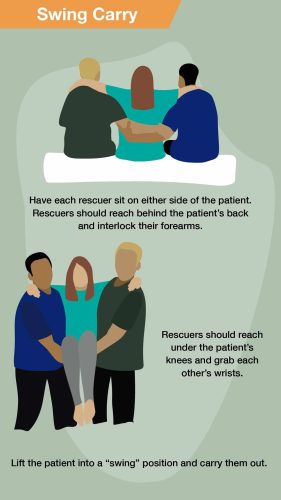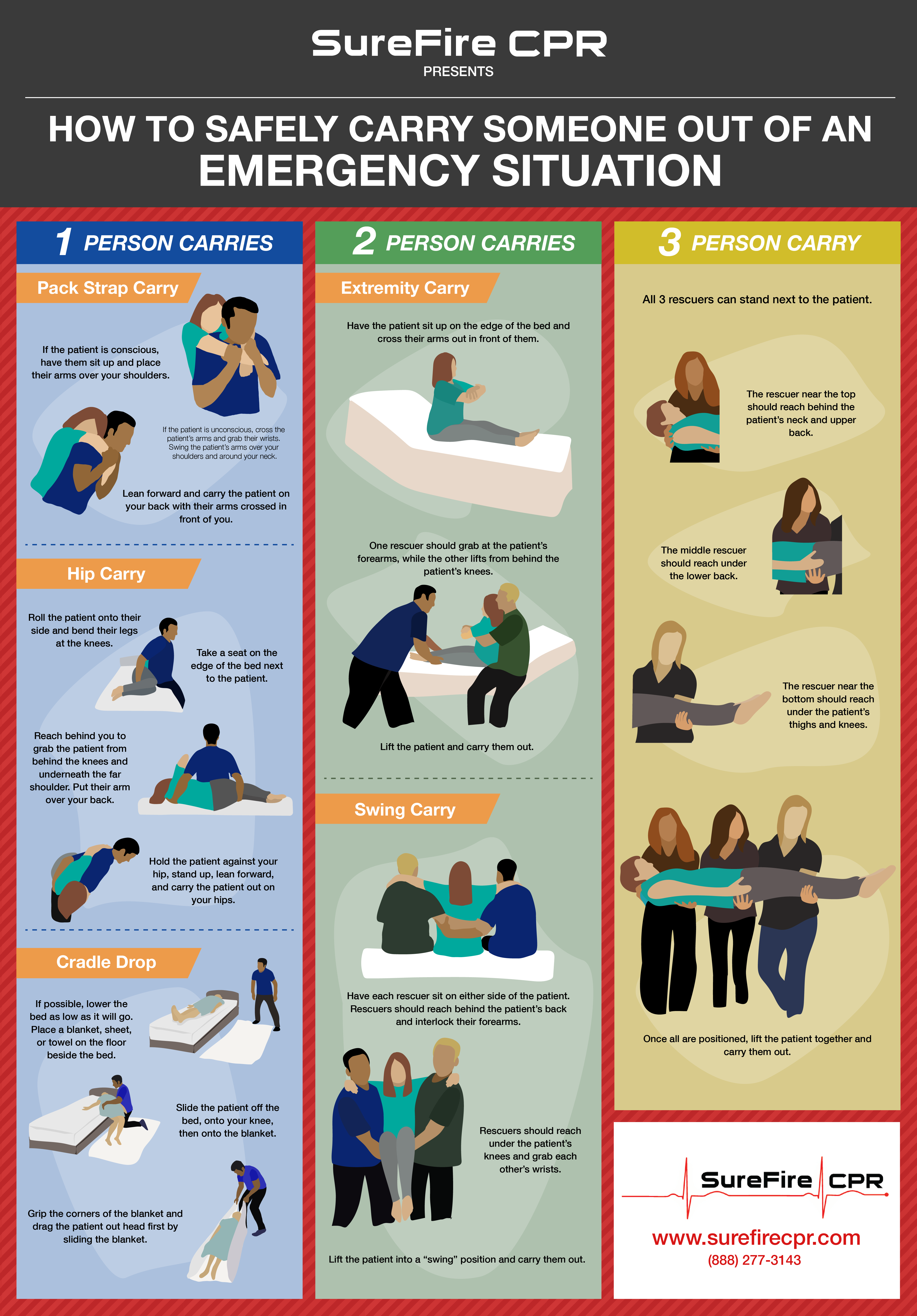If a fire starts or another emergency occurs in a hospital, patients and employees alike may need to relocate or evacuate. But what if a patient is unconscious, injured, or otherwise unable to move? If so, you might employ rescue drag and carry techniques.
Why are patient carry techniques important?
It’s more difficult than you may think to carry a patient, especially if they’re unconscious. Knowing how to carry a patient in an emergency enables you to act efficiently and quickly. It’s important to use patient carry techniques for both the patient’s safety and your own.
What are the different types of drags and carries?
There are many different ways to carry someone out of an emergency. The method you select might depend on the number of people around to help, the patient’s weight, how quickly you need to move, and more.
Let’s go over some of the common carrying techniques.
1 Person Carries
Pack Strap Carry
Have the patient sit up if they’re able to. The patient should place their arms over your shoulders and hang on as you carefully stand up and carry them out. If the patient is unconscious, you can instead cross their arms, grab their wrists, and place their arms over your shoulders to drag the patient off the bed and carry them out.
Hip Carry
First roll the patient onto their side and bend their legs at the knees. Take a seat on the edge of the bed next to the patient. Then, reach behind you to grab the patient from underneath the knees and underneath the far shoulder. Once you’re able to lift them, stand up, lean forward, and carry the patient on your hip.
2 Person Carries
Extremity Carry
Have the patient sit up and cross their arms out in front of them. One of you should grab at the patient’s forearms, while the other lifts underneath the patient’s knees. Lift the patient and carry them out. This is the most common carry used for EMTs and firefighters, and is the safest 2 person carry for going down stairs.
Swing Carry
Sit on either side of the patient and place their arms around your shoulders. Interlock your forearms behind the patient and reach under the patient’s knees. Lift the patient into a “swing” position. The swing carry is preferred when picking up a patient out of a wheel chair.
Victim Drags
If carrying doesn’t seem possible, you might employ a victim drag. This is when a rescuer transports a patient by lifting part of their body and dragging them to safety, rather than lifting their entire body.
Drags can be helpful if you need to move a victim right away and don’t know how to get a patient off the floor. Rescuers will also use a victim drag in cases where the patient’s size makes a carry difficult or impossible. However, keep in mind that victim drags tend to be more uncomfortable for the patient and might result in injury, but can be much faster than patient carries. Only use this method if it is absolutely necessary.
There are a few different types of victim drags. The easiest and most comfortable option is to use a blanket, sheet, or towel to pull the victim to safety. If you do not have any of these items nearby, you can drag the patient by their shoulder or feet. When using any of these victim drag techniques, try to clear the area of debris as much as possible. If there is debris along the path, the patient might become further injured.
Mastering the Art of Emergency Carries
Knowing how to carry an unconscious person safely and effectively is an essential skill for all medical professionals and emergency response personnel. Strong rescue skills will help in a variety of life-threatening situations such as fires, explosions, flooding emergencies, and more.
If you want to master the art of emergency carries, take a training course. Hospital employees, first responders, and more can benefit from a professional-level Hospital Fire Safety certification. In this course, you’ll learn exactly what to do if you ever need to move an injured or unconscious patient. There’s no better way to learn than directly from the experts. SureFire CPR’s course is taught by experienced first responders with real knowledge gained from the field.
Best Practices for Carrying Individuals in Crisis
Moving someone improperly can cause a patient pain or worsen their injuries. It’s important to know the different ways to carry someone in an emergency so that you can get them to safety, safely.
Keep the following best practices in mind:
- Protect yourself. While it might be counterintuitive during an adrenaline-inducing emergency, you need to look out for your own safety, too. Make sure you don’t injure yourself in the process of lifting a patient.
- Lifting someone who is unconscious is very different than lifting a conscious person. They might feel heavier than you expect. Be physically and mentally prepared to lift dead weight. Always keep the patient’s weight close to your body when carrying to protect your lower back.
- If the victim is conscious, they might be upset. This can be distracting and upsetting for even trained rescuers. Remember that your primary goal is getting the patient to safety, so it’s important to stay focused.
- Don’t overexert yourself if you can avoid it. For example, if a patient is able to walk with assistance, don’t attempt to carry them. Instead, use a one-person walk assist. The more you can conserve your energy, the more patients you can rescue.
- When possible, two-person carries are safer and more efficient. If another staff member or able-bodied reducer is around, work together to rescue patients.
Key Principles for Swift and Secure Patient Carries
Knowing how to carry an injured person and how to lift an unconscious person is an important part of being prepared for an emergency. Proper technique will reduce the risk of injury for all. Remember, safe carrying techniques likely aren’t what you see in the movies. Instead of simply scooping a patient into your arms, use the proper techniques. It will be safer for both you and the patient in the long run.
Life safety is the priority in any situation. The goal is to get the patient to the safest place quickly, with as little disruption as possible.
Learn More with SureFire CPR
Want to learn more about safe carrying techniques? Become an emergency expert with a Hospital Fire Safety course from SureFire CPR.
Our Hospital Fire Safety certification class covers patient rescue, hospital fire protection systems, and more. Certified by the LA Fire Department, you can rest assured you’re getting the best possible education on this important subject. We also offer award-winning CPR and First Aid courses. Sign up for one (or more!) of our classes today.
FAQ’s
There are a few different carrying techniques. The best method depends on the number of rescuers available, the patient’s weight, and other factors.
You should only move an injured person if they are facing a life-threatening situation such as a fire. If there is no alternative, you should use one of the recommended patient carrying techniques.
Moving an injured person without training could result in injury for both the patient and the rescuer. The patient’s injuries could become worse if they are jostled or hit. If a rescuer lifts someone without proper technique, they could pull a muscle or become injured themselves.
Before you try to move an injured person, take a moment to assess their condition. Take note of any injuries they have. You should also assess the situation to determine which of the types of carries will be most effective.
There are a few common mistakes made when carrying an unconscious person, including moving too quickly, not using the correct carrying method, and forgetting proper emergency carrying techniques.


